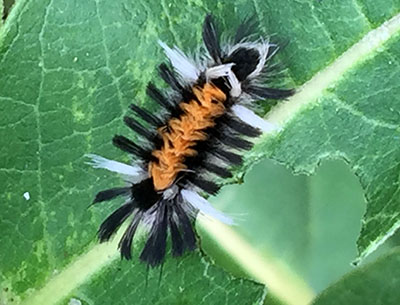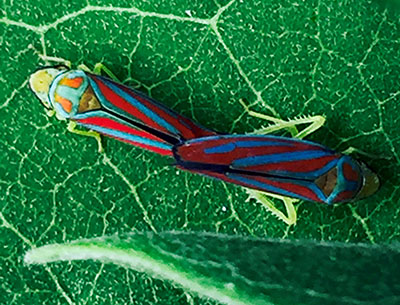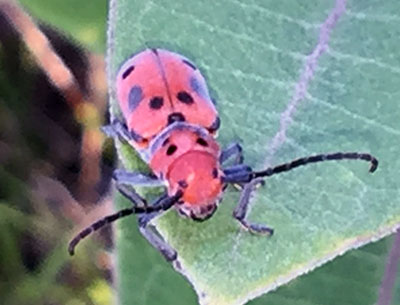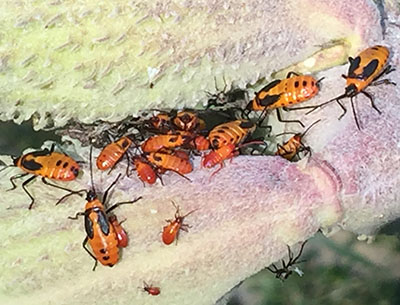Add common milkweed to your garden and make homeless insects happy
Milkweed plants can serve as host to many kinds of interesting insects, and can be grown using seeds of other milkweed plants.

Common milkweed (Asclepias syriaca) is a native plant with a robust appearance and a downy feel. Flower clusters are formed mostly where the leaves join the stems and are shades of dusty rose, lavender and occasionally a dull brownish-purple. They have a delightful, flowery fragrance. The gray-green seed pods are pointed and warty. Plants can grow from 3 feet to more than 6 feet tall during the growing season. The thick, white, Latex-like sap in the plant may irritate some people’s skin, but it serves as food for a number of insects that feed on it, and has the ability of being poisonous and unattractive to predators.
This summer and fall brought five interesting insects to the common milkweeds in my own garden. None of these tiny “livestock” kill the plants. A bit of leaf munching and sap sucking is all that is expected.
- Monarch butterflies (Danaus plexippus) are the best known insect to common milkweed. The larvae or juveniles are a crisp, lime green with black stripes. Adult butterflies are a very recognizable orange and black.
- Milkweed tussock moth (Euchaetes egle) larvae feed during mid-summer and start as small, white, hairy larvae and finish their larva lives as white, black and orange tufted fuzzy-wuzzies. See my article, “Milkweed tussock moth larvae feed on common milkweed,” for more information on this insect.

- Red-banded milkweed leafhoppers (Graphocephala coccinea) are red and blue insects with a definite triangular shape. They can be found in early summer.

- Red milkweed beetles (Tetraopes tetrophthalmus) are reddish-orange with black spots and can be found wandering on leaves in mid-summer.

- Large milkweed bugs (Oncopeltus fasciatus) are currently galloping over leaves and huddling on seed pods. Adults and several growth stages of juveniles can be found hanging out together. They are all orange with various amounts of black, depending on their age.

Planting milkweed from seeds
It isn’t necessary to buy milkweed plants for your gardens; all you need is permission from a milkweed plant’s owner to take some seeds. It’s important to remember, however, that unripe seeds do not germinate. Only a few annoying weeds will grow from unripe seeds. Wait until the milkweed pod has changed from green to tan on the outside and the interior looks silvery and a split has developed for the seeds to be released. The seeds are compacted inside. Before the pod has completely popped and the fliers are in the wind, carefully collect seeds and fluffy fliers. Put them into a paper bag or paper envelope so there is no chance of trapping any moisture. Dampness is the enemy of seeds at this point. Michigan State University Extension suggests keeping seeds as dry as possible.
Separate the fluffy fliers from the seeds. When the seeds are placed in the garden, they are supposed to stay where you put them. Prepare an area for the milkweed seeds that has bare, raked soil. Carefully drop the seeds and smooth a thin layer of soil over the seeds. Use a bit of light, mulch-like straw or dried grass clippings over the seeds and soil. The seeds need the winter for cold stratification, which involves being damp, freezing and thawing. Mark your area so you do not inadvertently pull up the milkweed. If unsure what the milkweed kiddies look like, wait until they are big enough to identify.
Keep in mind that all seeds will not grow, so always seed in more than you want. You can always share your excess plants with another smart gardener. Seeds may not emerge before July, so be prepared to wait. The plants will not bloom the first year. The second year and after, there should be milkweed blooms and tiny livestock for fun and enjoyment.
For for more information on growing milkweeds, see "Help monarchs and other pollinators by collecting milkweed seeds this fall" and "Growing milkweeds for monarch butterflies" by MSU Extension.



 Print
Print Email
Email



